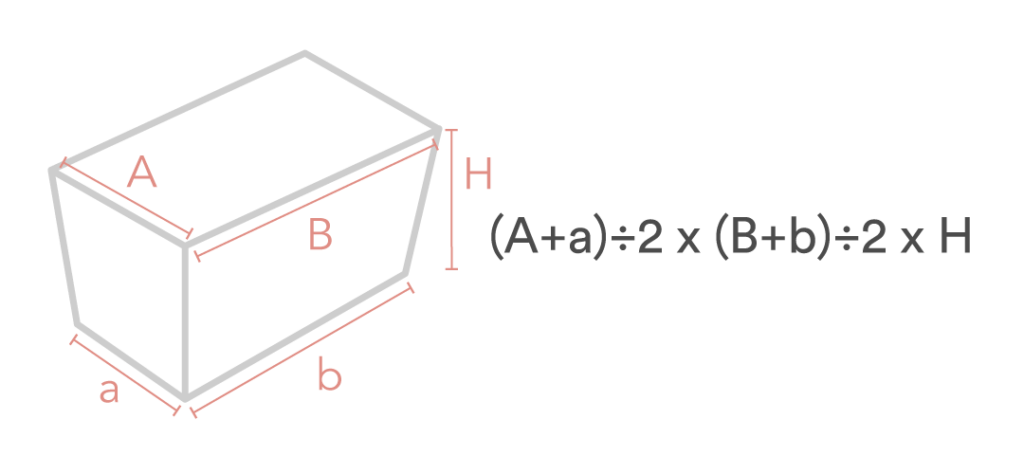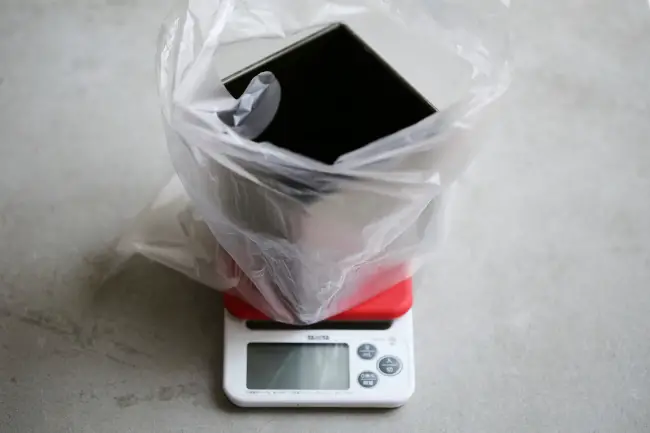Shokupan, known as Japanese milk bread, is the most common bread in Japan. It has a light and fluffy interior with subtle sweetness and milk flavor. There are a lot of Japanese milk bread recipes on the internet. But a bread pan size used in recipes may be different from a pan you have. So I will share how to adopt a recipe to fit your pan.

To explain clearly, I specified a sample Shokupan recipe and your pan size.
Sample Japanese milk bread recipe
Pan size: 12 x 12 x 12 cm
Ingredients
- 250g (100%) Bread flour
- 180g (72%) Milk
- 15g (6%) Sugar
- 15g (6%) Butter
- 5g (2%) Active dry yeast
- 5g (2%) Salt
( ) is baker’s percentage.
5 steps to convert a Japanese milk bread recipe to fit your pan
1. Find the capacity of a pan in the recipe.
You will be able to find the capacity of a pan by calculating the inside dimensions. In the case of the sample recipe, A, B and H is all 12cm, so the formula is 12cm x12cm x 12cm = 1728ml.

If the top and bottom widths are different, the formula is below.

2. Find the capacity of your pan.
There are two ways to find the capacity of your pan. The first is to use the formula above. The second is to pour water into a pan to the brim and measure its weight. When you try the second method, it’s better to put a pan in a plastic bag to prevent spilling water.

Sample your pan size.
Refer to the illustration in Step 1.
A: 11cm
a: 9cm
B: 20cm
b: 18cm
H: 11cm
So the capacity will be found from the formula below.
(11+9) ÷ 2 x (20+18) ÷ 2 x 11 = 2090ml
3. Calculate a ratio of dough weight to the pan in the recipe.
For standard Shokupan (Japanese milk bread) recipes, aim for a dough weight in grams that is around 4 times the volume of a pan. The higher the number, the less the amount of dough, and the smaller the number, the more amount of dough.
Here is a formula to find a ratio of dough weight in the recipe.
The capacity of the pan used in the recipe ÷ total weight of ingredients
The capacity of a pan in the sample recipe is 1728ml, as step 1 shows. About the total dough weight, you can find it by adding all ingredients in the recipe. But if a recipe use nuts or fruits, exclude them. In the sample recipe, the total weight of all ingredients is 470g.
Then formula will be as follow.
1728ml ÷ 470g =3.7
4. Calculate the right dough weight
The next step is to add all the baker’s percentages in the sample recipe. If a recipe you’re looking at doesn’t specify baker’s percentages, this site (baker’s percentage calculator) is useful to find the numbers.
Baker’s percent is the ratio of other ingredients when flour (flour) is 100%. So In the sample recipe I calculated like this.
- 250g (250g ÷ 250g x 100 = 100%) Bread flour
- 180g (180g ÷ 250g x 100 = 72%) Milk
- 15g (15g ÷ 250g x 100 = 6%) Sugar
- 15g (15g ÷ 250g x 100 = 6%) Butter
- 5g (5g ÷ 250g x 100 = 2%) Active dry yeast
- 5g (5g ÷ 250g x 100 = 2%) Salt
You will be able to know the right dough weight for your pan from this formula.
The capacity of your pan (from Step 2) ÷ ratio of dough weight (from Step 3) = dough weight to fit your pan
2090ml ÷ 3.7 = 564.8g
5. Calculate the right ingredients weight
At the Start, find the flour weight from this formula.
Dough weight to fit your pan (from Step 4) ÷ total number of baker’s percentages = the right flour weight for your pan
564.8g ÷ 188% = 300g flour weight
Once you find the right amount of flour, you can calculate other ingredient weights by multiplying baker’s percentages.
- 300g x 72% = 216g Milk
- 300g x 6% = 18g Sugar
- 300g x 6% =18g Butter
- 300g x 2% = 6g Active dry yeast
- 300g x 2% = 6g Salt
In this way, you can convert all the ingredients in the original recipe to fit your pan. It requires a little calculation, but it’s very convenient, so please utilize it to make a perfect Japanese milk bread.
